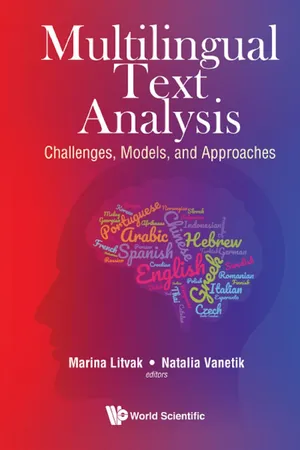
Multilingual Text Analysis
Challenges, Models, and Approaches
- 500 pages
- English
- ePUB (mobile friendly)
- Available on iOS & Android
About This Book
Text analytics (TA) covers a very wide research area. Its overarching goal is to discover and present knowledge — facts, rules, and relationships — that is otherwise hidden in the textual content. The authors of this book guide us in a quest to attain this knowledge automatically, by applying various machine learning techniques.
This book describes recent development in multilingual text analysis. It covers several specific examples of practical TA applications, including their problem statements, theoretical background, and implementation of the proposed solution. The reader can see which preprocessing techniques and text representation models were used, how the evaluation process was designed and implemented, and how these approaches can be adapted to multilingual domains.
Contents:
- Multilingual Text Analysis: History, Tasks, and Challenges (Natalia Vanetik and Marina Litvak)
- Using a Polytope Model for Unsupervised Document Summarization (Natalia Vanetik and Marina Litvak)
- MDL Approach for Unsupervised Multilingual Document Summarization (Natalia Vanetik and Marina Litvak)
- Rich Feature Spaces and Regression Models in Single-Document Extractive Summarization (Alexander Dlikman, Marina Litvak, and Mark Last)
- Hierarchical Topic Model and Summarization (Lei Li and Yazhao Zhang)
- A Survey of Neural Models in Abstractive Summarization (Tal Baumel and Michael Elhadad)
- Headline Generation as a Sequence Prediction with Conditional Random Fields (Carlos A Colmenares, Marina Litvak, Amin Mantrach, Fabrizio Silvestri, and Horacio Rodríguez)
- Crowdsourcing in Single-document Summary Evaluation: The Argo Way (Nikiforos Pittaras, Stefano Montanelli, George Giannakopoulos, Alfio Ferrara, and Vangelis Karkaletsis)
- Multilingual Summarization and Evaluation Using Wikipedia Featured Articles (John M Conroy, Jeff Kubina, Peter A Rankel, and Julia S Yang)
- Are Better Summaries Also Easier to Understand? Analyzing Text Complexity in Automatic Summarization (Elena Lloret, Tatiana Vodolazova, Paloma Moreda, Rafael Muñoz, and Manuel Palomar)
- Twitter Event Detection, Analysis, and Summarization (Natalia Vanetik, Marina Litvak, Efi Levi, and Andrey Vashchenko)
- Linguistic Bias in Crowdsourced Biographies: A Cross-lingual Examination (Jahna Otterbacher, Ioannis Katakis, and Pantelis Agathangelou)
- Multilingual Financial Narrative Processing: Analyzing Annual Reports in English, Spanish, and Portuguese (Mahmoud El-Haj, Paul Rayson, Paulo Alves, Carlos Herrero-Zorita, and Steven Young)
Readership: This book is intended for both students and professionals. Generation;Text Extraction;Deep Learning;Topic Model;Neural Model;Minimal Description Length principle;Regression Model;Summary Evaluation;Text Complexity;Social Media;Event Detection;Event Analysis;Linguistic Bias;Crowdsourcing;Financial Narrative Processing0 Key Features:
- Summarizes up-to-date research of MultiLing scientific community
- Focuses on language-independent methods and models
- Broad range of text analysis tasks is covered
Frequently asked questions
Information
Chapter 1
Multilingual Text Analysis: History, Tasks, and Challenges
∗[email protected]
†[email protected]
1. Introduction
2. TA evolution
3. TA overview
3.1. TA areas
Table of contents
- Cover page
- Title page
- Copyright
- Acknowledgment
- Preface
- Contents
- 1. Multilingual Text Analysis: History, Tasks, and Challenges
- 2. Using a Polytope Model for Unsupervised Document Summarization
- 3. MDL Approach for Unsupervised Multilingual Document Summarization
- 4. Rich Feature Spaces and Regression Models in Single-Document Extractive Summarization
- 5. Hierarchical Topic Model and Summarization
- 6. A Survey of Neural Models for Abstractive Summarization
- 7. Headline Generation as a Sequence Prediction with Conditional Random Fields
- 8. Crowdsourcing in Single-document Summary Evaluation: The Argo Way
- 9. Multilingual Summarization and Evaluation Using Wikipedia Featured Articles
- 10. Are Better Summaries Also Easier to Understand? Analyzing Text Complexity in Automatic Summarization
- 11. Twitter Event Detection, Analysis, and Summarization
- 12. Linguistic Bias in Crowdsourced Biographies: A Cross-lingual Examination
- 13. Multilingual Financial Narrative Processing: Analyzing Annual Reports in English, Spanish, and Portuguese
- List of Abbreviations
- List of Contributors
- Index